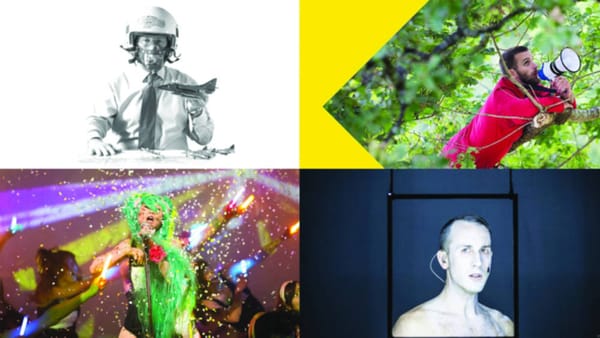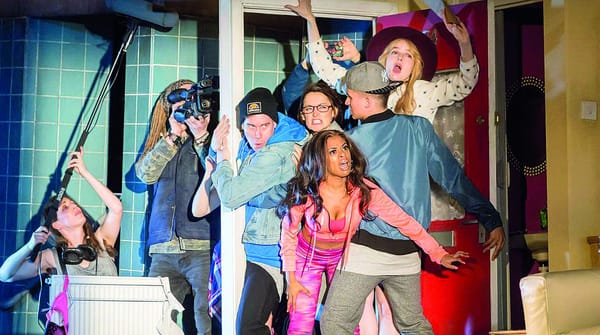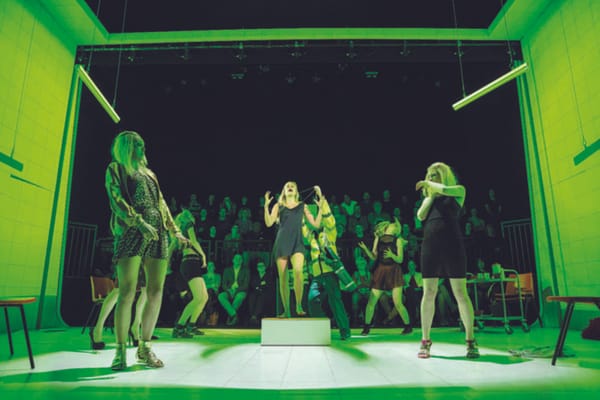Is David Hockney all he's cracked up to be?
He's beloved by the public, he's very prolific, but do his paintings stand up to scrutiny?

Soon, London art galleries will be in the throes of a David Hockney takeover. Starting from July, the Royal Academy will showcase ‘82 portraits and one still life’, and beginning in February next year, the Tate will host a comprehensive retrospective spanning decades of the artist’s work. It should come as no surprise that the capital’s major art institutions are falling over themselves to get a slice of the Hockney pie; for most of his 50 plus year long career he has been an imminently popular artist, far outstripping his Brit Pop contemporaries from the Royal College of Art in the race for public recognition.
His popularity has come as somewhat of a double edged sword. His mass appeal has proved to have an inverse correlation with the regard in which critics hold him.
At his best, Hockney’s work fizzes with energy, and seems to have something important to say. In one of earliest paintings, We Two Boys Clinging Together, named for the Walt Whitman poem, reveal his homosexuality, showing two figures intertwined, other paintings code his attraction towards Cliff Richards. Hockney moved to Los Angeles in 1966 and adopted a style of painting that would define the rest of his career.
In the 1967 painting, A Bigger Splash, Hockney conjures up a vision of Los Angeles that is haunting. Bright, flat colours fill neat. clinically geometric shapes. Oppressive Californian heat, rises from the red brick paving around the pool and permeates the painting. The hard lines are disturbed only by a scribble of white in the centre of the canvas. The viewer is left to imagine the identity of the unseen diver who has left the splash in their wake. American Collectors is another painting that is perfectly evocative of that particular Los Angeles glamour. Two figures, Fred and Marcia Weisman, she in a pink robe, he in a funereal black suit stand stiffly amongst their modern art acquisitions. Their poses are stiff, as if they were cardboard cut-outs. An undercurrent of sinisterness runs through the composition the brightness is disquieting, An atmosphere of money, boredom, and disillusionment is palpable.
If Hockney’s semi-naïve style suits the Los Angeles paintings perfectly, it is not so effective in his other works. In the series A Bigger View, exhibited in 2012 at the Royal Academy, he trades the West Coast sunshine for the more temperate climes of his native Yorkshire. Bright ceruleans are exchanged for bright viridians and huge canvases tacked together depict vistas of rolling hills outlined in navy blue, intersected by unspooling lilac ribbons of country paths. The bright, bold, and flat colours, so effective in portraying Los Angeles become saccharine sweet in their depiction of Yorkshire.
These landscapes are pure escapism, showing a nostalgic, idyllic view of the English countryside, unravaged by any signs of modernity. The choice of colours and the brushstrokes make it clear that Hockney's style is not a response to the landscape but an inflexible filter like tool he applies to whatever he sees before him. The compositions are pretty, but comfortable, entirely safe. They would not look out of place on a chocolate box or an illustrated edition of The Hobbit as pictures of Tolkein’s The Shire.
The most interesting of the bunch is May Blossom on the Roman Road, in which huge hawthorne bushes come alive with blossom that looks like writhing maggots desperate to be free of the green foliage. Here, there is an hint of menace that lends interest. That the landscapes are so uninspiring are a shame because Hockney's paintings of Eccleshill, again in Yorkshire in the 1950s are evocative and filled with loose, seemingly effortless brushwork. By comparison, his later work seems contrived.
In A Bigger View, Hockney seems unable to move on from the past, both from his own prior work and that of artists he admires. Anything more than a cursory glance of Early Blossom, Woldgate reveals his inspirations, the bright colours, the brushwork seem lifted wholesale from Van Gogh, but hold none of the frenetic emotional depth of Van Gogh's own work.
Van Gogh is a frequent source of inspiration in Hockney’s work, the pen and ink linework in Mother, Bradford (1978) is heavily influenced by Van Gogh’s early work. Van Gogh is far from the only influence; the Paper Pool series is reminiscent of Matisse’s Cut-Outs. The graphic splash in A Large Diver (Paper Pool 27) harkens back to the burst of light that appear in Matisse’s Icarus (1946).
Hockney has spoken at length about his love affair with Pablo Picasso's work. It has shaped a great deal of his output, in particular the 'joiners' series which encompassed his output in the 1980s. In these works, such as Pearblossom Highway Hockney manipulates polaroids and photographs into cubist collages. In doing so however, he is never able to step out of Picasso's shadow to say something new. The images feel gimmicky and pastiche-like. A quick search of the Hockney tag on Instagram reveals a host of users sharing their holiday pictures, pictures of desks in the 'joiner' style. In many instances only the content of the photographs, the hipster mug or finished geography homework give away that Hockney could not have created them: never a sign of a robust artistic movement.
Hockney has had an extraordinarily prolific career, moving from medium to medium throughout his 50 year career. His latest project involved iPad drawings, most notbaly of the Yosemite National Park.
If there was any proof needed that Hockney's work is overrated beyond parody in recent years, the response to these iPad drawings are it.
We've all heard the old addage that a two-year-old could draw that; often it is employed unjustly, a two-year-old would not produce aJackson Pollock painting, and fine, neither would they produce a Hockney if let loose on the drawing app, but a twelve-year-old might.
It's not the use of the iPad that's objectionable, digital paintings are very often accomplished and gloriously beautiful, but Hockney's are anything but. These are conventional landscapes executed poorly, and what's worse exhibited with a seriousness that defies belief. These paintings are testament to the decline of an once interesting artist.
The new show at the Royal Academy is mercifully not filled with iPad drawings but a series of acrylic portraits of Hockney's friends and family.
The sitters appear against the the same background of a mid blue, and turquoise, all seated in the same chair. Hockney considers the dozens of portraits one cohesive work, and it's clear how the background has been kept minimal and the same throughout to shift the attention onto the sitters. For me, the background staying the same does almost the opposite, the sitters take the role of the props, akin to light changing across a wall. This is a shame, Hockney's portraits of his mother painted throughout his career are emotional, deeply personal paintings that reveal Hockney's true skill at portraiture, by contrast the new paintings are closer to illustrations.
Hockney is a prolific artist who has for many years demonstrated a knack for connecting with the public. That is no mean feat, and nothing to sniffed at, but it has become and more apparent that as an artist he has little new to say.
It's interesting to speculate how his work would've developed had he not to moved to Los Angeles at the beginning of his career, or had continued to explore his sexuality in his work, even in his paintings of swimming pools, the most evocative are of his then lover, Peter Schlesinger. These criticisms have been levelled at Hockney over decades, which he brushes off with ease. His productivity far from declining over recent years, has increased. This is to be admired, he clearly creates work that many people enjoy, and that in itself is something to be celebrated. All the same, the retrospective at the Tate will probably be more worth checking out than the exhibition of new work at the Royal Academy.








